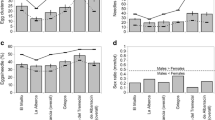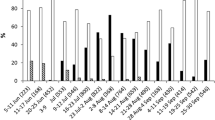Abstract
In Bulgaria near Marikostino, in a forest ofPinus nigra Arn. 239 egg batches were sampled over four generations ofThaumetopoea pityocampa (Den. & Schiff.) (Lep., Thaumetopoeidae) in various seasons. Directly after collection the batches were singled in test tubes, closed with cotton stoppers and stored under laboratory conditions at 20–22°C.
Oviposition always started from the base towards the tip of the needles. The emergence of egg parasitoids was observed daily, and the parasitoids were counted and identified.
The eggs from which parasitoids emerged were marked for further studies. After removing the adults and opening the eggs, the impact of the species of parasitoids was evaluated by identifying the meconia and other rests (left overs).
Ooencyrtus pityocampae (Mercet) was the most abundant egg parasitoid, followed byAnastatus bifasciatus (Fonsc.). Only few individuals ofBaryscapus servadeii (Dom.) were collected. The hyperparasitoidBaryscapus servadeii (Dom.) were collected. The hyperparasitoidBaryscapus transversalis Graham, was found at low densities. Only a few eggs were parasitised byTrichogramma embryophagum Htg. Total mortality of the host eggs varied from 34.7 to 79.7% depending on the period of parasitism and on the numbers of sterile eggs. The impact of the parasitoids was calculated to be 9.3–38.9%, depending on the period when parasitism had taken place.
The mean number of eggs per batch varied from 203 to 253. The rate of parasitism was reduced by early sampling of the egg batches. In some cases, a very high percentage (up to 29.2%) of undeveloped eggs was found. In all samples a small percentage of empty eggs was always observed.
Zusammenfassung
In Bulgarien, in der Nähe von Marikostino, wurden 239 Eigelege des PinienprozessionsspinnersThaumetopoea pityocampa (Den.& Schiff.) (Lep., Thaumetopoeidae) in einemPinus nigra Forst über 4 Generationen zu verschiedenen Jahreszeiten gesammelt. Die Gelge wurden sogleich einzeln in Reagensgläser gegeben, die mit Wattestopfen verschlossen wurden, und unter Laborbedingungen bei 20–22°C aufbewahrt. Die Eiablage fand stets von der Nadelbasis zur Spitze hin statt.
Der Schlupf der Parasitoiden wurde täglich registriert. Nach Entfernen der Gelegeschuppen wurde jedes Ei markiert, aus dem ein Parasitoid schlüpfte. Alle adulten Parasitoide wurden sogleich nach dem Schlupf entfernt und zur Determination vorbereitet. Nach Ende der Schlupfperiode (mindestens 1 Jahr nach dem Raupenschlupf) wurden alle Eier geöffnet. Der Einfluß der cinzelnen Parasitoiden-Arten auf die Eimortalität wurde anhand der Mekonien und Rückstände in den Eiern bewertet.
Ooencyrtus pityocampae (Mercet) war in den Eiern die häufigste Art, gefolgt vonAnastatus bifasciatus (Fonsc.) VonBaryscapus servadeii (Dom.) wurden nur wenige Individuen gefunden. Auch der Hyperparasitoid,Baryscapus transversalis Graham, war nur in geringer Populationsdichte vertreten. Nur wenige Eier waren vonTrichogramma embryophagum Htg. parasitiert. Die Gesamtmortatität der Wirtstiere variierte von 34,7% bis 79,7%; sie war abhängig von der Parasitierungsperiode und der Menge an sterilen Eiern. Der Einfluß der Eiparasitoide betrug 32,7–38,9%, wenn sie die gesamte Embryonalentwicklung des Wirtes zur Parasitierung nutzen konnten.
Die mittlere Anzahl der Eier pro Gelege variierte in den Sammelproben von 203 bis 253. Die Parasitierungsrate war nach frühem Einsammeln der Gelege (nach Oviposition des Wirtes) stark reduziert. In einigen Fällen war ein sehr hoher Prozensatz (bis zu 29,2%) an nicht entwickelten Eiern zu finden. In allen Eigelegen waren einige Eier vorhanden, die total leer waren.
Similar content being viewed by others
Literature
Baldassari, N.;Rocchetta, G.;Baronio, P., 1994: Sviluppo di una popolazione isolata diThaumetopoea pityocampa (Den. & Schiff.) (Lepidoptera Thaumetopoeidae) sottoposta a confusione sessuale. Boll. Ist. Entomol. ‘Guido Grandi’ Univ. Stud. Bologna48, 185–193.
Baronio, P.;Baldassari, N.;Scaravelli, D., 1992: Evoluzione quantitativa di una populazione diThaumetopoea pityocampa (Den. & Schiff.) (Lepidoptera, Thaumetopoeidae) trattata conil della cattura in massa. Frustula entomol.XV, 1–9.
Battisti, A., 1986: Ricerche bio-ecologiche e demografiche suThaumetopoea pityocampa (Denis & Schiffermüller) in pinete diPinus nigra Arnold delle Prealpi orientali. Tesi di Dottorato, Univ. Padova.
Bellin, S., 1995: Zur Biologie vonBaryscapus transversalis Graham (Hym.: Eulophidae), Hyperparasitoid der Primärparasitoiden vonThaumetopoea pityocampa (Den. & Schiff.) (Lep.: Thaumetopoidae). Mitt. Dtsch. Ges. Allg. Angew. Ent9, 453–457.
Bellin, S.;Schmidt, G. H.;Douma-Petridou, E., 1990: Structure, ooparasitoid spectrum and rate of parasitism of egg-batches ofThaumetopoea pityocampa (Den. & Schiff.) (Lep., Thaumetopoeidae) in Greece. J. Appl. Ent.110, 113–120.
Biliotti, E., 1958:Les parasities et predateurs deThaumetopoea pityocampa Schiff. (Lepidoptera). Entomophaga3, 23–34.
Breuer, M.;Devkota, B., 1990: Control ofThaumetopoea pityocampa (Den. & Schiff.) by extracts ofMelia azedarach L. (Meliaceae). J. Appl. Ent110, 128–135.
Breuer, M.;Devkota, B.;Douma-Petridou, E.;Koutsaftikis, A.;Schmidt, G. H., 1989: Studies on the exposition and temperature of nests ofThaumetopoea pityocampa (Den & Schiff.) (Lep., Thaumetopoeidae) in Greece. J. Appl. Ent.107, 370–375.
Demolin, G., 1969: Comportement des adults deThaumetopoea pityocampa Schiff. Dispersion spatiale, importance écologique. Ann. Soc. forest.26(1), 81–102.
Frerot, B.;Demolin, G., 1993: Sex pheromone of the processionary moths and biosistematic considerations within the genusThaumetopoea (Thaumetopoeidae, Thaumetopoeinae). Boll. Zool. agr. Bachic., Ser. II,25, 33–40.
Geri, C., 1984: Repartition et evolution des populations de la processionnaire du pin,Thaumetopoea pityocampa Schiff. (Lep., Thaumetopoeidae) dans les montagnes Corses. II. Relations entre les populations et le milieu physique et forestier. Acta Oocologia, Oecol. Applic.5(1), 3–22.
Halperin, J., 1970:Thaumetopoea wilkinsoni Tams: Its biology, ecology and natural enemies. Diss. Univ. Jerusalem (in Hebr.).
Halperin, J., 1990: Natural enemies ofThaumetopoea spp. (Lep., Thaumetopoeidae) in Israel. J. Appl. Ent.109, 425–437.
Kitt, J.;Schmidt, G. H., 1993: Parasitism of egg-batches of the pine processionary mothThaumetopoea wilkinsoni (Lep., Thaumetopoeidae) in the mountains of Lahav (Israel). J. Appl. Ent.115 484–498.
Lamy, M., 1990: Contact dermatitis (erucism) produced by processionary caterpillars (GenusThaumetopoea). J. Appl. Ent.110, 425–437.
Masutti, L., 1964: Ricerche sui parassiti oofagi dellaThaumetopoea pityocampa (Schiff.). Ann. Centro Econ. Mont. Ven.4, 205–271.
Masutti, L.;Battisti, A., 1990:Thaumetopoea pityocampa (Den & Schiff.) in Italy. Bionomics and perspectives of integrated control. J. Appl. Ent.110, 229–234.
Nicolini, G., 1987: Biologia della processionaria del pino in Trentino. Lotta tradizionale con attrattivi sessual di sintesi. Dendronatura,8, 8–49.
Schmidt, G. H., 1988: Das Eigelege des KiefernprozessionsspinnersThaumetopoea pityocampa Schiff. (Lep.: Thaumetopoeidae), Struktur, Larvenschlupf und Parasitierung in Südgriechenland. Mitt. Dtsch. Ges. Allg. Angew. Ent.6 (4), 323–337.
Schmidt, G. H., 1990: The egg-batch ofThaumetopoea pityocampa (Den. & Schiff.) (Lep: Thaumetopoeidae): Structure, hatching of the larvae and parasitism in southern Greece. J. Appl. Ent.110, 217–228.
Schmidt, G. H.;Douma-Petridou, E., 1989): A contribution to parasitism of egg batches ofThaumetopoea pityocampa (Den. & Schiff.) (Lepidoptera, Thaumetopoeidae) on the Peloponnes (Greece). Boll. Zool. agr. Bachic., Ser. II,21, 141–151.
Schmidt, G. H.;Kitt J., 1994: Identification by meconia of two egg parasitoids ofThaumetopoea wilkinsoni. Phytoparasitica22 (1), 39–41.
Schmidt, G. H.;Tsankov, G.;Mirchev, P. 1997: Notes on the egg parasitoids ofThaumetopoea pityocampa (Den. & Schiff.) (Insecta Lepidoptera Thaumetopoeidae) collected on the Greek island Hydra. Boll. Zool. agr. Bachic, Ser. II,29 (1), 91–99.
Tanzen, E.;Schmidt, G. H., 1995: Identification by meconia of four species of egg parasitoids ofThaumetopoea pityocampa (Den. & Schiff.) (Insecta, Lepidoptera, Thaumetopoeidae). Boll. Zool. agr. Bachic. Ser. II,27 (1), 61–70.
Tiberi, R.;Niccoli, A., 1984: Osservazioni pluriennali sull’ impiego di trappole con il feromone sessuale diThaumetopoea pitycampa (Denis & Schiffermüller) (Lep., Thaumetopoeidae). Redia67, 129–144.
Tsankov, G., 1972: Varhu biologiyatâ i ecologiyata na yaytseyadite ne borovata procesionka (Thaumetopoea pityocampa Schiff.). v Bâlg. Sborn. Biol. borba sreshtu naseke vredit. No. 1.
Tsankov, G., 1990: Egg parasitoids of the pine processionary mothThaumetopoea pityocampa (Schiff.) in Bulgaria: species, importance, biology and behaviour. J. Appl. Ent.110, 7–13.
Tsankov, G.;Mirchev, P 1993: Environmental sound principles in using bacterial preparations for regulation of population densities of the pine processionary mothThaumetopoea pityocampa (Den. & Schiff.) in Bulg. For. Sc.2, 72–82. (in Bulgarian).
Tsankov, G.;Schmidt G. H.;Mirchev, P., 1996: Parasitism of egg batches of the pine processionary mothThaumetopoea pityocampa (Den. & Schiff.) (Lep., Thaumetopoeidae) in various regions of Bulgaria. J. Appl. Ent.120, 93–105.
Author information
Authors and Affiliations
Additional information
The research conducted was supported by the Government of Lower Saxony, Hannover, Germany.
Rights and permissions
About this article
Cite this article
Tsankov, G., Schmidt, G.H. & Mirchev, P. Studies on the egg parasitism inThaumetopoea pityocampa over a period of four years (1991–1994) at marikostino/bulgaria. Anz. Schadlingskde., Pflanzenschutz, Umweltschutz 71, 1–7 (1998). https://doi.org/10.1007/BF02770563
Issue Date:
DOI: https://doi.org/10.1007/BF02770563




